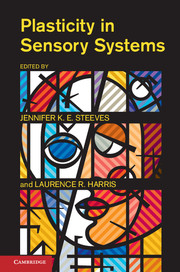Book contents
- Frontmatter
- Contents
- List of Contributors
- 1 Plasticity in Sensory Systems
- I VISUAL AND VISUOMOTOR PLASTICITY
- II PLASTICITY IN CHILDHOOD
- III PLASTICITY IN ADULTHOOD AND VISION REHABILITATION
- 9 Visual Plasticity of the Adult Brain
- 10 Beyond the Critical Period: Acquiring Stereopsis in Adulthood
- 11 Plasticity and Restoration after Visual System Damage: Clinical Applications of the “Residual Vision Activation Theory”
- 12 Applying Plasticity to Visual Rehabilitation in Adulthood
- Author Index
- Subject Index
- References
11 - Plasticity and Restoration after Visual System Damage: Clinical Applications of the “Residual Vision Activation Theory”
from III - PLASTICITY IN ADULTHOOD AND VISION REHABILITATION
Published online by Cambridge University Press: 05 January 2013
- Frontmatter
- Contents
- List of Contributors
- 1 Plasticity in Sensory Systems
- I VISUAL AND VISUOMOTOR PLASTICITY
- II PLASTICITY IN CHILDHOOD
- III PLASTICITY IN ADULTHOOD AND VISION REHABILITATION
- 9 Visual Plasticity of the Adult Brain
- 10 Beyond the Critical Period: Acquiring Stereopsis in Adulthood
- 11 Plasticity and Restoration after Visual System Damage: Clinical Applications of the “Residual Vision Activation Theory”
- 12 Applying Plasticity to Visual Rehabilitation in Adulthood
- Author Index
- Subject Index
- References
Summary
In this chapter, we discuss the recently proposed residual vision activation theory that is based on both human and animal studies (Sabel, Henrich-Noack, et al., 2011). The central point of the theory is that partially damaged brain systems have a particularly good potential for restoration of vision. Fortunately, in the clinical world, complete visual system lesions are extremely rare because complete damage is only found in total eye or optic nerve damage or some severe congenital defects. As a consequence, even in patients considered to be legally blind, there is almost always some degree of residual vision and hence restoration potential.
This chapter focuses on human studies and therapeutic applications that build on the “residual vision activation theory.” We discuss work with patients that suffered postretinal lesions to the central visual pathway. Although visual fields may recover spontaneously to some extent, after the first few weeks or months following damage, this recovery no longer continues in most cases. Therefore, we focus on the time after this initial recovery and consider the effects of training procedures and noninvasive alternating current stimulation as an innovative mean to kindle vision restoration long after the lesion has occurred. Both treatment approaches restore visual fields, mainly in areas that were not absolutely blind but have some residual capacities. The nature of residual vision, its measurement, and the role of activating residual vision as a means to promote recovery of vision are discussed.
- Type
- Chapter
- Information
- Plasticity in Sensory Systems , pp. 196 - 228Publisher: Cambridge University PressPrint publication year: 2012



